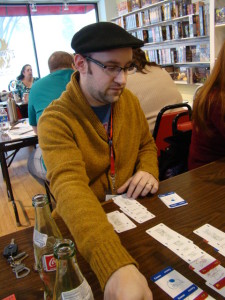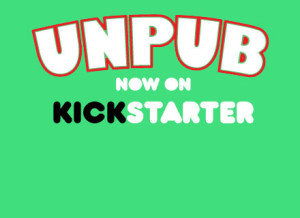Understanding the Feedback Form
 You may have noticed something new showing up on some Kickstarter pages lately--a box with 7 circles ranging from 1-5, with the Unpub logo nearby. In fact they probably mostly range from 4-5. These same circles also show up on some Unpub.net game pages (when enabled by the creator) and on feedback pages in the designer admin area. These numbers represent the average ratings of different aspects of games when people fill out feedback forms at an Unpub event. They help other players know what the game is like, and help the designers see what areas they need to focus on.
You may have noticed something new showing up on some Kickstarter pages lately--a box with 7 circles ranging from 1-5, with the Unpub logo nearby. In fact they probably mostly range from 4-5. These same circles also show up on some Unpub.net game pages (when enabled by the creator) and on feedback pages in the designer admin area. These numbers represent the average ratings of different aspects of games when people fill out feedback forms at an Unpub event. They help other players know what the game is like, and help the designers see what areas they need to focus on.

When you use the official feedback form, there are 7 categories that accept a numerical rating:
- Game length
- Learning Ease
- Decisions
- Downtime
- Interactivity
- Originality
- Fun
These terms are somewhat subjective, and leave it to the player to decide what rating each category deserves. Let’s look at each category and see what a good rating in each means.
 First, game length is one of the most straightforward ratings, because it is easy to tell how long the game took. But this doesn’t mean that short games are given small numbers and long games are given high numbers. Unpub feedback used to rate game length on a scale of too short-just right-too long. With the switch to numerical ratings on a scale of 1 to 5, we lose some detail about whether players think it is too long or too short. A game dragging on too long is obviously bad, but a game that feels like it ends right before you get a chance to accomplish something might be just as disappointing. If it felt too rushed, or took too long to get interesting, this can have a big impact, even if the raw game time was exactly as promised. This is a good opportunity to contribute comments if you think the length was inappropriate.
First, game length is one of the most straightforward ratings, because it is easy to tell how long the game took. But this doesn’t mean that short games are given small numbers and long games are given high numbers. Unpub feedback used to rate game length on a scale of too short-just right-too long. With the switch to numerical ratings on a scale of 1 to 5, we lose some detail about whether players think it is too long or too short. A game dragging on too long is obviously bad, but a game that feels like it ends right before you get a chance to accomplish something might be just as disappointing. If it felt too rushed, or took too long to get interesting, this can have a big impact, even if the raw game time was exactly as promised. This is a good opportunity to contribute comments if you think the length was inappropriate.
Next, learning ease is still fairly easy to rate. Generally, the faster it is to teach, the easier the rules are, and the higher the score should be. But the rating shouldn’t be solely based on how long it takes to explain the rules; it should also take into account who the audience is, how complicated the game is, and how well you understand the rules at the end. Your personal feelings about game length is valuable, to help find the audience. If you felt it was too long or short, let the designer know what you like to play. Not all explanations need to cover everything at once. Some games are better explained by slowly adding rules as the game progresses. On the other hand, some games feel like there are exceptions to everything that you don’t find out until you try to do it. A good way to gage this is whether you feel like you can teach the game to someone else after playing. If there are specific rules that were hard to understand, let the designer know. It can be very hard to see what makes sense when you know the rules so well. Understanding the rules and understanding the strategy are two different things, but both can influence how easy a game is to learn. Did the rules and strategy make sense before the final turn, or is a learning game appropriate? It can be discouraging if you feel like you have to struggle through several games before you can hope to do well. It can be just as disappointing to feel like you know everything there is to know after a single game. So tell the designer your level of understanding the strategy. A high score represents a sweet spot where the game is appropriately easy to pick up, but hard to master. Finally, remember that often, designers are still working out a lot of the rules on the fly, or teaching it for the first time, so learning it might not be as smooth as a released game. Give suggestions if you see a way it would be easier to teach.
Rating interactivity is similar to rating game length, and depends on what the game is trying to accomplish. More interaction generally improves a game, but only to a point. And there are both obvious and subtle types of interaction to consider. Are players locked in combat? Is there negotiation? What about trading? Are players competing for the same actions, resources, or locations on the board? Are players working together or fighting each other? Some players dislike bluffing or combat, some players relish it, making this is a very difficult aspect to rate clearly. The best advice I have is to think about whether the type of interaction used is appropriate for the game, in addition to how much there is. Did you feel like you were interacting with other people in the way you wanted to? And how did it affect your enjoyment of the game? If it felt right and was fun, give it a good score, if not, tell the designer what felt out of place or would have been more fun.
 Downtime is somewhat related to game length and interaction, but it is really a measure of engagement. And the group of players can have a major impact on how this feels. I’ve played games at unpub that were supposed to be 60 minutes that ended up taking 2 ½ hours, and 2 hour games that finished in 45 minutes. And especially if you are playing with people you’ve just met, it’s sometimes hard to identify how much is due to the game, and how much is due to the players. Try to separate the actual time you spent from how you spent the time. Did you need to be aware of everything happening on other players’ turns? Or maybe the time between turns gave you the opportunity to plan out your next series of moves. If the time between turns was long, but useful, that isn’t necessarily a bad thing. A high level of interaction can reduce the amount of downtime by making sure you always have something to do, but it can also make the game seem frantic if you don’t get a chance to pause. Let the designer know what you were thinking between turns, because that might be a great way to add something to the game.
Downtime is somewhat related to game length and interaction, but it is really a measure of engagement. And the group of players can have a major impact on how this feels. I’ve played games at unpub that were supposed to be 60 minutes that ended up taking 2 ½ hours, and 2 hour games that finished in 45 minutes. And especially if you are playing with people you’ve just met, it’s sometimes hard to identify how much is due to the game, and how much is due to the players. Try to separate the actual time you spent from how you spent the time. Did you need to be aware of everything happening on other players’ turns? Or maybe the time between turns gave you the opportunity to plan out your next series of moves. If the time between turns was long, but useful, that isn’t necessarily a bad thing. A high level of interaction can reduce the amount of downtime by making sure you always have something to do, but it can also make the game seem frantic if you don’t get a chance to pause. Let the designer know what you were thinking between turns, because that might be a great way to add something to the game.
The score for decisions depends on and relates to all of the previous categories, but is difficult to define. Is it the number of decisions? Or the difficulty of the decisions? What about how much they affect gameplay? How long is a piece of string? The answer depends on what you want to get out of a game, and what the designer wants you to get out of it. If you want a complicated game, hard decisions are an important element. But casual games should have easier decisions. A lot of decisions can be great if you want the players to be constantly reevaluating the game, but a more tense game might benefit from hinging on just a few big ones. On the other hand, too few decisions or too easy decisions can make a player feel disengaged from the consequences of the action, and too many, or too difficult can make players feel like they are struggling. Decisions should always feel varied and important, but the difficulty and number depend on the feel of the game. One of the best pieces of feedback you can give the designer is to tell them what decisions you enjoyed making, and which ones you struggled with.
Originality is one of the easier categories to consider, but you should consider both the theme and the mechanics. A standard theme applied to innovative mechanics, or a wildly different theme with a mix of established mechanics should both gain high scores. Don’t just give it a rating based on whether you like the theme or mechanics. Even if neither the theme nor mechanics is new, but they are put together in a new way, that might be enough. Think about the games you’ve seen and played, and see if it feels like something else. If it does, be sure to let the designer know what games it reminds you of. Maybe the game intentionally draws inspiration, and maybe the designer has never heard of the games it reminds you of. Just telling the designer that it doesn’t feel new can be one of the hardest things to hear, so tell the designer why, and help them improve the game.
 Finally, fun is probably the most important category, and is simultaneously one of the easiest and most difficult categories to score. Easiest because after you play, you know whether you had fun or not. But hardest because explaining why it was fun or not takes a lot of thought. It’s totally fair and expected to be subjective in this category. If the game really hits a sweet spot with you, great. If it falls short, that’s ok too. But it is absolutely critical to tell the designer what parts resonated with you or turned you off.
Finally, fun is probably the most important category, and is simultaneously one of the easiest and most difficult categories to score. Easiest because after you play, you know whether you had fun or not. But hardest because explaining why it was fun or not takes a lot of thought. It’s totally fair and expected to be subjective in this category. If the game really hits a sweet spot with you, great. If it falls short, that’s ok too. But it is absolutely critical to tell the designer what parts resonated with you or turned you off.
The next time you play an Unpub game, keep these categories in mind before starting. When you finish the game, take a moment to think about each category before picking a score. The more thoughtful you are, the more designers will appreciate it, and the more useful the feedback will be. As a player, providing feedback is the single most important thing you can do to contribute to Unpub. And giving thoughtful feedback is the best way to do this.




Very well written Nathaniel, thank you